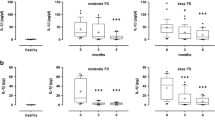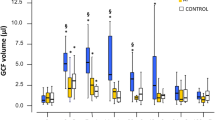Abstract
Objective
The aim was to investigate a possible association between the immunoexpression of interleukin (IL)-4 and clinicopathological parameters with the periodontal breakdown observed in gingival pyogenic granuloma (PG).
Materials and methods
Paraffin-embedded samples of gingival PG (n = 46) were prepared for histological and immunohistochemical assessment. Demographic and clinical parameters were assessed by criteria based on age stratum, gender, smoking habit, evolution course, location, lesion size, macroscopic appearance, predisposing factors, recurrence, and periodontal breakdown. Histological assessment included the appearance of epithelial lining, microvessel density, inflammatory infiltrate density, interstitial fibrosis, and histological arrangement. A staining intensity distribution (SID) score was used to assess IL-4 immunoreactivity. The association between candidate predictor variables and periodontal breakdown was analyzed individually and adjusted for confounding using a bivariate binary logistic regression model.
Results
Mean IL-4 SID values were significantly increased for long-standing and large lesions, presence of periodontal breakdown, high microvessel density, and moderate-to-severe inflammatory infiltrate density. While bivariate and univariate analyses revealed a positive association of the evolution course ≥12 months, lesion size >1 cm, high microvessel density, moderate-to-severe inflammatory infiltrate density, and IL-4 SID score ≥8.04 with periodontal breakdown, after bivariate logistic regression analysis, only the evolution course ≥12 months, moderate-to-severe inflammatory infiltrate density, and IL-4 SID score ≥8.04 remained as robust predictors of periodontal damage. Confounding and interaction effects between candidate predictor variables were also noted.
Conclusion
These findings suggest that while evolution course, inflammatory infiltrate density, and the overexpression of IL-4 may act as predictors of periodontal breakdown in gingival PG, there are mutual confounding and synergistic biological interactive effects with respect to the lesion size and microvessel density in the susceptible host that may be also associated with the bone resorption and tissue destruction.
Clinical relevance
Although the first-line therapy of gingival PG continues to be the surgical excision, this approach poses unwanted complications such as severe mucogingival defects and recurrence. Hence, early diagnosis and detection of these three significant predictor variables as well as timely surgical excision might help prevent the periodontal tissue destruction observed in some of these lesions.




Similar content being viewed by others
References
Bhaskar SN, Jacoway JR (1966) Pyogenic granuloma-clinical features, incidence, histology, and result of treatment: report of 242 cases. J Oral Surg 24:391–398
Angelopoulos AP (1971) Pyogenic granuloma of the oral cavity. Statistical analysis of its clinical features. J Oral Surg 29:840–847
Jafarzadeh H, Sanatkhani M, Mohtasham N (2006) Oral pyogenic granuloma: a review. J Oral Sci 48:167–175
Kamal R, Dahiya P, Puri A (2012) Oral pyogenic granuloma: various concepts of etiopathogenesis. J Oral Maxillofac Pathol 16:79–82
Gordón-Núñez MA, de Vasconcelos CM, Benevenuto TG, Lopes MF, Silva LM, Galvão HC (2010) Oral pyogenic granuloma: a retrospective analysis of 293 cases in a Brazilian population. J Oral Maxillofac Surg 68:2185–2188
Epivatianos A, Antoniades D, Zaraboukas T, Zairi E, Poulopoulos A, Kiziridou A, Iordanidis S (2005) Pyogenic granuloma of the oral cavity: comparative study of its clinicopathological and immunohistochemical features. Pathol Int 55:391–397
Vassilopoulos SI, Tosios KI, Panis VG, Vrotsos JA (2011) Endothelial cells of oral pyogenic granulomas express eNOS and CD105/endoglin: an immunohistochemical study. J Oral Pathol Med 40:345–351
Isaza-Guzmán DM, Teller-Carrero CB, Laberry-Bermúdez MP, González-Pérez LV, Tobón-Arroyave SI (2012) Assessment of clinicopathological characteristics and immunoexpression of COX-2 and IL-10 in oral pyogenic granuloma. Arch Oral Biol 57:503–512
Shenoy SS, Dinkar AD (2006) Pyogenic granuloma associated with bone loss in an eight year old child: a case report. J Indian Soc Pedod Prev Dent 24:201–203
Yuan K, Jin YT, Lin MT (2000) The detection and comparison of angiogenesis-associated factors in pyogenic granuloma by immunohistochemistry. J Periodontol 71:701–709
Toida M, Hasegawa T, Watanabe F, Kato K, Makita H, Fujitsuka H, Kato Y, Miyamoto K, Shibata T, Shimokawa K (2003) Lobular capillary hemangioma of the oral mucosa: clinicopathological study of 43 cases with a special reference to immunohistochemical characterization of the vascular elements. Pathol Int 53:1–7
Kovanen PE, Leonard WJ (2004) Cytokines and immunodeficiency diseases: critical roles of the gamma(c)-dependent cytokines interleukins 2, 4, 7, 9, 15, and 21, and their signalling pathways. Immunol Rev 202:67–83
Ratthé C, Ennaciri J, Garcês Gonçalves DM, Chiasson S, Girard D (2009) Interleukin (IL)-4 induces leukocyte infiltration in vivo by an indirect mechanism. Mediators Inflamm 2009:193970
Fujihashi K, Kono Y, Beagley KW, Yamamoto M, McGhee JR, Mestecky J, Kiyono H (1993) Cytokines and periodontal disease: immunopathological role of interleukins for B cell responses in chronic inflamed gingival tissues. J Periodontol 64(5 Suppl):400–406
Hart PH, Vitti GF, Burgess DR, Whitty GA, Piccoli DS, Hamilton JA (1989) Potential antiinflammatory effects of interleukin 4: suppression of human monocyte tumor necrosis factor alpha, interleukin 1 and prostaglandin E2. Proc Natl Acad Sci U S A 86:3803–3807
te Velde AA, Huijbens RJ, Heije K, de Vries JE, Figdor CG (1990) Interleukin-4 (IL-4) inhibits secretion of IL-1β, tumor necrosis factor-α and interleukin-6 by human monocytes. Blood 76:1392–1397
Ukai T, Mori Y, Onoyama M, Hara Y (2001) Immunohistological study of interferon-gamma- and interleukin-4-bearing cells in human periodontitis gingiva. Arch Oral Biol 46:901–908
Niiro H, Otsuka T, Izuhara K, Yamaoka K, Ohshima K, Tanabe T, Hara S, Nemoto Y, Tanaka Y, Nakashima H, Niho Y (1997) Regulation by interleukin-10 and interleukin-4 of cyclooxygenase-2 expression in human neutrophils. Blood 89:1621–1628
Nagano S, Otsuka T, Niiro H, Yamaoka K, Arinobu Y, Ogami E, Akahoshi M, Inoue Y, Miyake K, Nakashima H, Niho Y, Harada M (2002) Molecular mechanisms of lipopolysaccharide-induced cyclooxygenase-2 expression in human neutrophils: involvement of the mitogen-activated protein kinase pathway and regulation by anti-inflammatory cytokines. Int Immunol 14:733–740
Cui X, Yang SC, Sharma S, Heuze-Vourc’h N, Dubinett SM (2006) IL-4 regulates COX-2 and PGE2 production in human non-small cell lung cancer. Biochem Biophys Res Commun 343:995–1001
Cho W, Kim Y, Jeoung DI, Kim YM, Choe J (2011) IL-4 and IL-13 suppress prostaglandins production in human follicular dendritic cells by repressing COX-2 and mPGES-1 expression through JAK1 and STAT6. Mol Immunol 48:966–972
Pradeep AR, Roopa Y, Swati PP (2008) Interleukin-4, a T-helper 2 cell cytokine, is associated with the remission of periodontal disease. J Periodontal Res 43:712–716
Masinovsky B, Urdal D, Gallatin WM (1990) IL-4 acts synergistically with IL-1β to promote lymphocyte adhesion to microvascular endothelium by induction of vascular cell adhesion molecule-1. J Immunol 145:2886–2895
Clinchy B, Elenstrom C, Severinson E, Moller G (1991) T and B cell collaboration: induction of motility in small, resting B cells by interleukin 4. Eur J Immunol 21:1445–1451
Hiester AA, Metcalf DR, Campbell PA (1992) Interleukin-4 is chemotactic for mouse macrophages. Cell Immunol 139:72–80
Dubois GR, Bruijnzeel PL (1994) IL-4-induced migration of eosinophils in allergic inflammation. Ann N Y Acad Sci 725:268–273
Callard RE (1991) Immunoregulation by interleukin-4 in man. Br J Haematol 78:293–299
Yssel H, Schneider P, Spits H (1993) Production of IL-4 by human T cells and regulation of differentiation of T-cell subsets by IL-4. Res Immunol 144:610–616
Tokoro Y, Matsuki Y, Yamamoto T, Suzuki T, Hara K (1997) Relevance of local Th2-type cytokine mRNA expression in immunocompetent infiltrates in inflamed gingival tissue to periodontal diseases. Clin Exp Immunol 107:166–174
Taylor PC (2003) Anti-cytokines and cytokines in the treatment of rheumatoid arthritis. Curr Pharm Des 9:1095–1106
Rezvani G, Azarpira N, Bita G, Zeynab R (2010) Proliferative activity in oral pyogenic granuloma: a comparative immunohistochemical study. Indian J Pathol Microbiol 53:403–407
Flórez-Moreno GA, Henao-Ruiz M, Santa-Sáenz DM, Castañeda-Peláez DA, Tobón-Arroyave SI (2008) Cytomorphometric and immunohistochemical comparison between central and peripheral giant cell lesions of the jaws. Oral Surg Oral Med Oral Pathol Oral Radiol Endod 105:625–632
Garlet GP, Martins W Jr, Ferreira BR, Milanezi CM, Silva JS (2003) Patterns of chemokines and chemokine receptors expression in different forms of human periodontal disease. J Periodontal Res 38:210–217
Saravana GH (2009) Oral pyogenic granuloma: a review of 137 cases. Br J Oral Maxillofac Surg 47:318–319
Yamazaki K, Nakajima T, Gemmell E, Polak B, Seymour GJ, Hara K (1994) IL-4 and IL-6-producing cells in human periodontal disease tissue. J Oral Pathol Med 23:347–353
Yamazaki K, Nakajima T, Hara K (1995) Immunohistological analysis of T cell functional subsets in chronic inflammatory periodontal disease. Clin Exp Immunol 99:384–391
Lappin DF, Macleod CP, Kerr A, Mitchell T, Kinane DF (2001) Anti-inflammatory cytokine IL-10 and T cell cytokine profile in periodontitis granulation tissue. Clin Exp Immunol 123:294–300
Hassuneh MR, Nagarkatti PS, Nagarkatti M (1997) Evidence for the participation of interleukin-2 (IL-2) and IL-4 in the regulation of autonomous growth and tumorigenesis of transformed cells of lymphoid origin. Blood 89:610–620
Toi M, Harris AL, Bicknell R (1991) Interleukin-4 is a potent mitogen for capillary endothelium. Biochem Biophys Res Commun 174:1287–1293
Fukushi J, Morisaki T, Shono T, Nishie A, Torisu H, Ono M, Kuwano M (1998) Novel biological functions of interleukin-4: formation of tube-like structures by vascular endothelial cells in vitro and angiogenesis in vivo. Biochem Biophys Res Commun 250:444–448
Fukushi J, Ono M, Morikawa W, Iwamoto Y, Kuwano M (2000) The activity of soluble VCAM-1 in angiogenesis stimulated by IL-4 and IL-13. J Immunol 165:2818–2823
Conflict of interest
The authors declare that they have no financial interest in the products in this work. This study has been fully supported by a grant of the Research Development Committee of the University of Antioquia (CODI-Code 8700-1617/2009).
Author information
Authors and Affiliations
Corresponding author
Rights and permissions
About this article
Cite this article
González-Pérez, L.V., Isaza-Guzmán, D.M. & Tobón-Arroyave, S.I. Association study between clinicopathological variables and periodontal breakdown in gingival pyogenic granuloma. Clin Oral Invest 18, 2137–2149 (2014). https://doi.org/10.1007/s00784-014-1195-4
Received:
Accepted:
Published:
Issue Date:
DOI: https://doi.org/10.1007/s00784-014-1195-4




